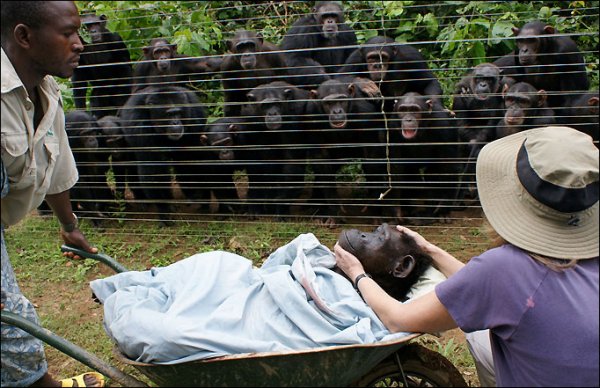Dorothy’s mother was killed by hunters. They then sold her to an amusement park in Cameroon where she was chained to the ground and taught to drink beer and smoke cigarettes for noisy crowds.

After a rollercoaster life, Dorothy died at a chimpanzee rescue center in Cameroon. This photo, showing her chimp family observing the burial, went viral on the internet and raised the question, can animals really exhibit funeral behavior?
Poor diet and lack of exercise made Dorothy obese. In May of 2000, she was brought to Cameroon’s Sanaga-Yong Chimpanzee Rescue Center and rehabilitated. She became a favorite at the center and even mothered a child of her own. But in September of 2008, she died of congestive heart failure. The management let her chimpanzee family witness the burial. “Some chimps displayed aggression while others barked in frustration,” a worker who photographed the event later explained. “But perhaps the most stunning reaction was a recurring, almost tangible silence. If one knows chimpanzees, then one knows that they are not usually silent creatures.”
The photo of the chimp funeral went viral on the internet and was published in the November 2009 issue of National Geographic. It shows Dorothy under a light blue sheet in a wheelbarrow being pushed to the burial site by a park worker. Another worker holds Dorothy’s head gently in her hands. Behind a fence in the background are more than a dozen chimpanzees, staring intently, looking visibly sad. Chimpanzees, along with African elephants, ants, and magpies are some of the few animals known to exhibit funeral behavior. Interestingly, they are all social animals. “Perhaps their grief reactions function as a social signal that allows for reshuffling of status relationships, facilitates filling of the reproductive vacancy left by the deceased, or fosters continuity of the group,” speculates Janis Dickinson of Cornell’s Ornithology Lab in an essay on yellow-billed magpies.
READ ABOUT HOW GORILLAS, PARROTS AND HORSES COMMIT SUICIDE TOO
When a yellow-billed magpie dies, other magpies will swoop down to the carcass and hop about, making loud squawking noises. The display is considered a funeral-related action and was discovered in 1972 by a biologist named Nicholas Verbeek. “Could the magpies be expressing grief?” questions Dickinson. Until further research is done, nobody really knows for certain. But Mark Bekoff, of the University of Colorado, thinks they just might be. In 2009, he released a paper describing the results of a study where he spent time observing magpies alongside a magpie corpse. Two actually approached the corpse, gently pecking at it, then stepped away. Another flew off, only to return with some grass which it laid on the body. “We can’t know what they were actually thinking or feeling,” said Bekoff. “But reading their action there’s no reason not to believe these birds were saying a magpie farewell to their friend.”
African elephants have been known to gather around decaying corpses and bawl. They touch the bodies with their trunks and sometimes bury the carcass with tree branches. They’ll even remove bones and tusks, pass them around, or carry them off. In 2008, a 38-year-old elephant named Tequila, living at the Toronto Zoo, died suddenly. Staff found her daughter Thika standing beside her mother’s body for hours, digging at the ground and throwing dirt over the body. “Elephants are extremely intelligent,” explained one zoo official. Two years prior, zoo staff videotaped the funeral behavior that followed the death of a 40-year-old elephant named Patsy. “The elephants who got along with Patsy came up to touch her with their trunks while the ones who fought with her stood further back,” reported a newspaper article.
FUNERAL ETIQUETTE—WHAT TO SAY AND WHAT TO DO
And then there are ants. We have all seen the lines of them weaving along the floor of the forest or our living room, mysteriously keeping to the same path. What not everyone notices is that when an ant dies in line, a certain ant comes along to remove the body, the undertaker ant. It will gather up all the corpses and make a pile, then mine sand from the colony’s tunnel system, one grain at a time, and use it to cover them. One particularly contemplative blogger describes the experience of observing undertaker ants at work: “Questions entered my mind as I watched them. Why didn’t they just bring the bodies down into the tunnels with them instead of bringing the sand up to the bodies? Why did they want to bury the bodies in the first place? Are there minister ants to speak at the funerals?”










Tina
This post is full of grief.
astral stone
I remember how this went viral. Look at all those chimps watching as their fellow chimp is being taken away for burial. Animals with high intelligence really deserve to be buried.